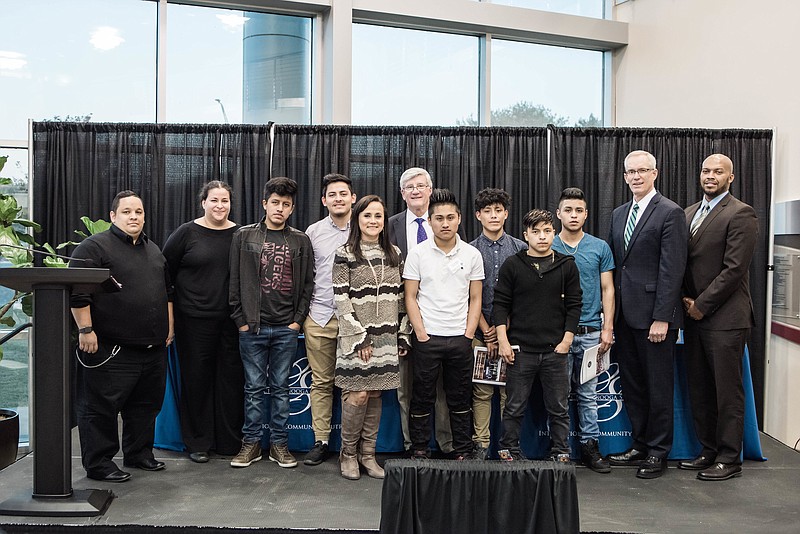As the Hispanic community in Chattanooga grows, the Hamilton County Department of Education, Chattanooga State Community College and local nonprofit organizations are working together to develop programs to help English language learners succeed.
In 2000, Hispanics and Latinos accounted for 1.8 percent of the county's population, but by 2016, they made up 5.1 percent, according to data from the U.S. Census Bureau.
More Info
Chattanooga State will host a forum on Monday, May 7 to share more findings from the first year of the Bridges to Success 2.0 course.
While a large majority of Latinos feel welcomed in Hamilton County, according to a 2015 survey conducted by the nonprofit La Paz Chattanooga, they also face many unique challenges.
Low levels of English proficiency combined with a lack of Spanish language support has been the greatest challenge facing the community, according to La Paz.
"Every day we have people contacting us wanting to participate in English courses," said Patrick Miles, director of community engagement and administration at La Paz.
Hispanic students account for roughly 10 percent of the student body in Hamilton County, and close to 6 percent have limited English proficiency. As a whole, these English language learners (ELL) fall behind at every level of education.
In grades three through eight, 6.3 percent of ELL students and 17.2 percent of Hispanic students were on track or advanced in English Language Arts assessments, compared to 31.5 percent of all students in Hamilton County, according to the Tennessee Department of Education report card.
In high school English assessments, 2 percent of ELL students and 11.2 percent of Hispanic students were on track or better, compared to 26.4 percent of all students. The graduation rate in Hamilton County is 84.6 percent for all students, but 77.9 percent for Hispanic or Latino students, and 62.2 percent for ELL students.
In addition to the obvious language barrier that exists when school is entirely conducted in English, many ELL students face additional cultural barriers, said Miles. Most English learners are immigrants, and they may come from a country where education is viewed very differently.
"If we're not going to support our ELL community, the ELL students will struggle," Miles said, adding that when an entire segment of the student body falls behind, it affects schools' grades and state funding.
Acknowledging the need to address the needs of the ELL community, HCDE has partnered with nonprofit organizations like La Paz and Chattanooga 2.0 as well as Chattanooga State to develop strategies for closing the education gap.
"We need to be very intentional about supporting our ELL population as it continues to grow in Hamilton County," Schools Superintendent Dr. Bryan Johnson said.
One strategy is Bridges to Success 2.0. Run by Chattanooga State, the pilot program helps put ELL high school juniors and seniors on a path to higher education and a future career.
BTS 2.0 is modeled after an adult version, Bridges to Success, which Chattanooga State has offered for the past four years. The original version helps immigrants by combining English language learning, civic education and job training.
During the two-year 2.0 program, students spend their mornings in regular high school classes, but in the afternoon and summer, they take bilingual computer technology classes, and can graduate high school with a computer support technician certificate from the Tennessee College of Applied Technology.
"Even if they are not able to join a university right away, they will have something to lay back on; they will have a prestigious profession; they will be walking with their heads up and with enough support from the community," said Anjelika Riano, coordinator of family and community partnerships and language acquisition programs for HCDE.
The pilot program consists of 17 Latino, ELL students from The Howard School, chosen based on counselor recommendation and interest. The certificate program is free to the selected students, paid for by Chattanooga State and fundraising.
Howard is one of the schools that has been most dramatically affected by the growing Hispanic population. During the 2012-2013 school year, the student body was 89 percent black or African-American and had fewer Hispanic and Latino students than white students. In the 2016-2017 school year, the school makeup was 58.3 percent black and 36.9 percent Hispanic or Latino.
Gladys Pineda-Loher, director of international community outreach at Chattanooga State, hopes the BTS 2.0 program will forge a path to post-secondary education, create job opportunities and improve quality of life for the ELL students it serves.
"Sometimes English language learners are the last to know about opportunities. By addressing this particular community, we're working to close the equity gap in education," she said.
The individualized attention seems to be paying off. Pineda-Loher said the initial 17 students are excelling in other academic areas and becoming leaders within the ELL community at Howard.
